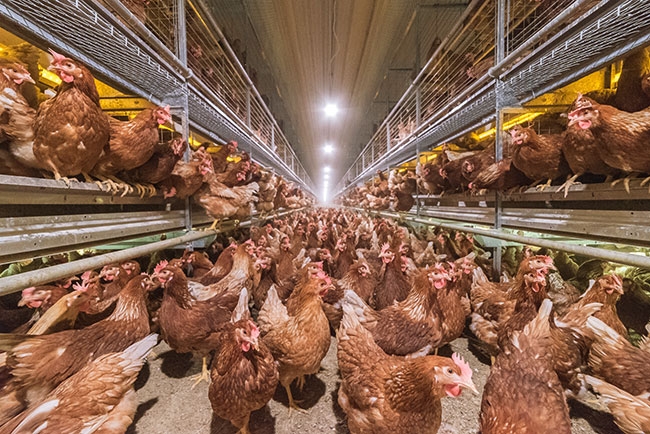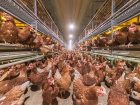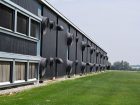
Ventilating free-run layer barns
By Treena Hein
Features Equipment Layers Poultry Equipment Production Alternative poultry housing annex Cage free Canada Egg production Phasing Out Conventional Production VentilationControlling ammonia and dust levels is important for birds and workers.
 Experts note that the more litter space in a laying facility, the dryer the litter will be and the better the ventilation system will be able to function. Photo: Big Dutchman
Experts note that the more litter space in a laying facility, the dryer the litter will be and the better the ventilation system will be able to function. Photo: Big DutchmanConventional cage laying barns have always been dusty, notes Harry Huffman, an agricultural engineer based in London, Ont. “Thus, I would assume the new floor and aviary style of housing systems will continue to be dusty as well.” Huffman notes that the more important ventilation design parameters in a layer barn hinge around the number and size of birds being housed, and how airflow should occur through the airspace to accommodate the building specs.
These parameters include the width, length and height of the building, as well as installed equipment, including feeders, waterers and so on.
“Ventilation is based off air exchanges per animal,” Jonathan Kasa, partner at Nor-Ag in Red Deer, Alta., says. “Then we get specific, based on temperature, humidity, CO2, drafts, air flow, etc. These free-run layer barns have a much higher number of birds per cubic foot than broiler barns, so every aspect of proper ventilation is magnified and it’s far more important to design a proper system.”
Dr. Hongwei Xin, assistant dean for research in the College of Agriculture and Life Sciences at Iowa State University, also agrees that compared to enriched colony and conventional cage housing, ventilation is more of a challenge in free-run layer barns. “One factor is manure accumulating and possible caking on the floor, which leads to some ammonia issues, and another is the higher dust levels from bird activities on the litter floor,” Xin says.
“Egg producers with free-run housing systems have to increase minimum ventilation to control indoor ammonia, especially in the wintertime. And, supplemental heat is needed in areas in the northern U.S. and Canada where the climate is colder.” He adds that in a free-run layer barn, there are fewer birds in the same amount of space compared to conventional cages or enriched colony housing. “Fewer birds means less body heat for warming the room air in wintertime,” he notes. “How to distribute the supplemental heat uniformly throughout the barn is a challenge, and producers must make sure air ducts flow freely and don’t get plugged with feathers. Overall, free-run barn ventilation system requires more maintenance and cost.”
Xin points to the large study completed by the Coalition for Sustainable Egg Supply, which involved a team of scientists evaluating three laying hen housing systems – coventional cage, enriched colony and aviary cage-free or free-run. The study authors found cost of production for free-run barn eggs was 36 per cent higher compared to the conventional cage, but Xin says that number takes much more than ventilation and supplemental heat costs into account. “There are fewer eggs on average per hen due to higher mortality caused by feather pecking, cannibalism, smothering and injuries in the free-run barn,” he notes. “As well as higher initial cost and higher labour costs from picking up floor eggs and de-dusting equipment for example, less efficiency in feed conversion and so on.”
The updated Canadian code of practice for laying hens requires that “environmental control systems must be designed, constructed and maintained in a manner that allows for fresh air and hygienic conditions that promote health and welfare for birds,” and that “action must be taken to manage ammonia levels if they reach a harmful range (e.g., 20 to 25 ppm).”
There are no specific requirements for dust, but Xin is not surprised. He notes that farm workers always wear dust masks in layer barns. “We’ve measured much higher dust levels in layer barns than the guideline values for workers by the U.S. Occupational Safety and Health Administration. Much more fresh air flows through the barns in mild to warm weather for temperature control, which lowers the dust concentrations, but in cold weather – winter and early spring – masks are definitely needed.”
Xin says that ventilation is only one factor of many that farmers must consider when deciding whether to go with enriched colony or free-run barn housing. “On a bird welfare basis, the hens have more room to move around in free-run barns, but smothering and injurious feather pecking can be worse, for example, than in enriched housing,” he notes. “From an air quality standpoint, there is half the ammonia and about eight times less dust in enriched colony housing compared to barn production.”
In terms of manure management, Bill Snow, aviary specialist for Big Dutchman, says if the quality of the litter is higher, hens will be more engaged to act out natural desires of foraging, dust bathing and scratching. However, he notes that “the better the quality of the litter, the more dust you are likely to have. Poor manure quality means higher levels of ammonia and good quality means more dust. The way we try to manage the dust levels in the house is to continually scrape litter out of the aisles.” The scraper is placed underneath the system row, Snow explains, and a path of litter is scraped from the front of the laying house to the rear. “The hens will go in and move the litter around and fill the bare areas back in,” Snow adds. “Each time the scraper system is run, litter is removed off the floor, and this keeps the height of the litter down to a workable level. This also helps to reduce miss laid eggs on the floor and reduces the dust levels in the house.”
Housing design certainly affects air quality, and Snow notes that the more litter space in a laying facility, the dryer the litter will be and the better the ventilation system will be able to function. “The benefit of upwards of 30 per cent litter space ensures that system rows are far enough apart from one another,” he explains, “so that fresh litter that falls into the aisle has a chance to dry out.”
Also, if perches are not placed over a manure belt, litter that is excreted falls directly onto the floor below and builds up quickly. The hens will then scratch through it and spread it around. “If the system rows are too close together, the build-up of manure from the perch will fall very close and does not have an opportunity to dry out because of the density of hens that are on the floor,” Snow explains. “The hens will be closely grouped together and ventilation will not reach the litter level as easily. The litter will not get the opportunity to dry.”
Print this page

